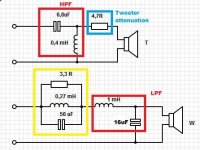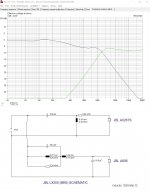Hi All,
I have a pair of JBL LX300 standmount speakers that "I'm playing with".
This is the European version, 4ohm, 2 way speaker with around 3Khz crossover point.
Now I was looking at this crossover schematics and would like someone to explain the crossover parts role.
As you can see in the attached drawing the red marked section are for the HPF and LPF filtering, as far as I understand the Blue marked resistor is for Tweeter attenuation, but is the yellow marked section for? what it's purpose?
Thanks
I have a pair of JBL LX300 standmount speakers that "I'm playing with".
This is the European version, 4ohm, 2 way speaker with around 3Khz crossover point.
Now I was looking at this crossover schematics and would like someone to explain the crossover parts role.
As you can see in the attached drawing the red marked section are for the HPF and LPF filtering, as far as I understand the Blue marked resistor is for Tweeter attenuation, but is the yellow marked section for? what it's purpose?
Thanks
Attachments
Thank you.It may be there to reduce a peak. It is working at around 1,300Hz.
Am I wrong or the 16uF capacitor in the LPF doesn't make sense?
What is the woofer's LP crossover freq?
Thanks
The woofer filter is set around 1,250Hz.. but maybe this is to offset a rising response, maybe also to do with the baffle step.
I've found this graph online, the difference is that in my crossover the tweeter attenuation resistor value is 4.7ohm and in the attached graph crossover drawing is 6.8ohm so I assume my speakers have more "sparkling" mids and treble and deeper dip in the crossover region which can be attenuated using a higher value resistor (-;The woofer filter is set around 1,250Hz.. but maybe this is to offset a rising response, maybe also to do with the baffle step.

